Roger Caffin
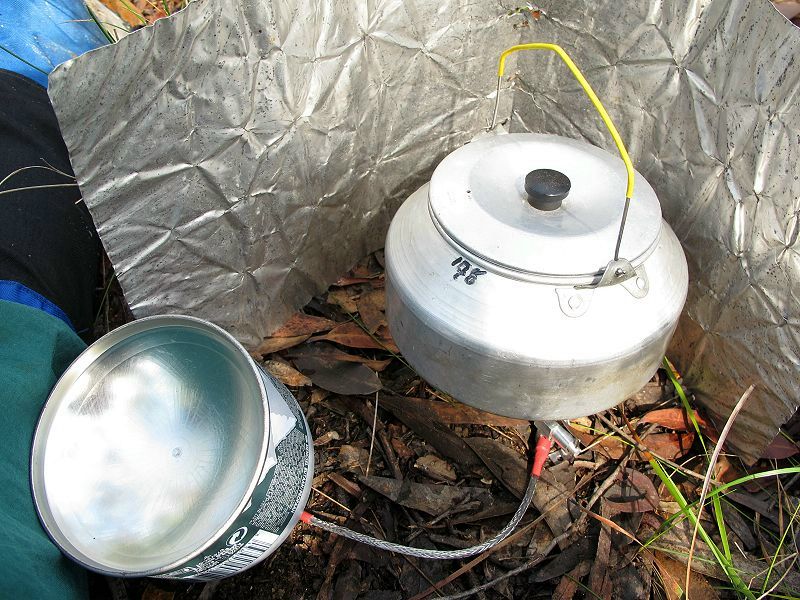
Morning tea coming up, with an earlier model
Dissatisfied with what was commercially available at the time, the author has been working on the design of a lightweight winter canister stove since 2007. (OK, OK, a bit obsessive, but so what?) Several novel features were required of the design, in the interests of versatility, functionality and safety. These features are explained in Part 1. In Part 2 I went into finer technical details about how the features might be implemented: all the choices which were possible. In this Part 3 the final design is presented: there are actually two variants. The choice between them depends primarily on the performance of the burners, but also on their availability from China.
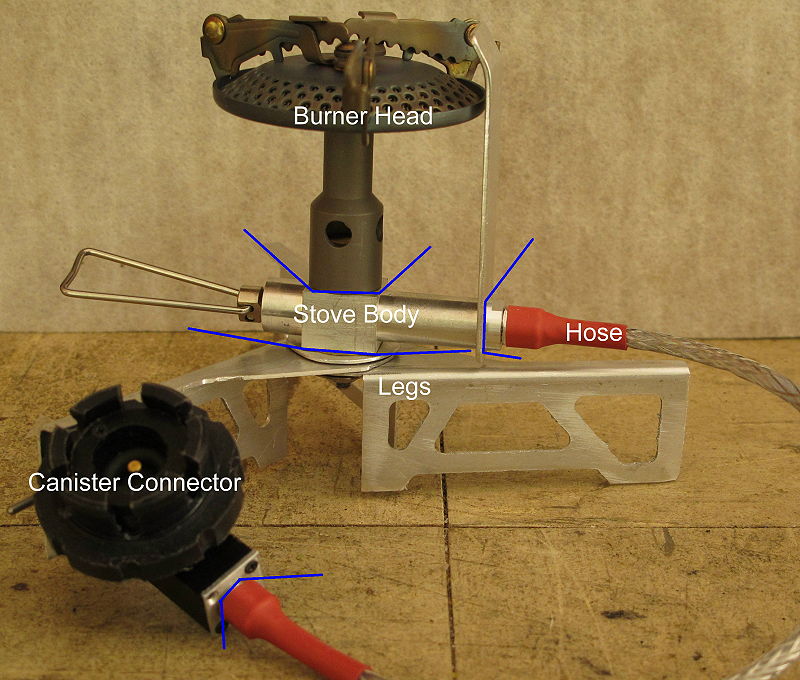
Showing the different sections of a winter stove
Choices had to be made. We will cover the canister connector unit, the hose, the stove body, the support legs and finally the burner selection. These are all illustrated here.
All three of the canister styles I want to handle use a Lindal valve, and that means they all have the same sort of undercut rim. So I decided to use a variant of the French Campingaz 'lugs' approach for the mechanical connection. Since the connector body stays cool or even cold at all times, the use of a light fuel-resistant engineering plastic for both the fingers and the locking cylinder is possible. Mind you, the Campingaz upright stoves use a (reinforced) high-temperature plastic for the 'spider' successfully, even though there is some warmth there. Many materials were tested before a suitable combination was found. Good wearing properties and strength were obvious requirements. Two obvious possibilities were nylon and acetal: both very good engineering plastics. The spider (see below) in this photo was machined from nylon: slight feathers are visible at the edges of the machining which is not so good. So ability to take precise machining was also required, which tilted the initial choice towards acetal. However, eventually the design changed to a different plastic to get better sliding performance. (Acetal tends to bind to acetal!)

The connector, using Campingaz-style lugs for retention (see notes below)
The green lines in the photo point to the lugs on what is called the 'spider': it has lots of slightly flexible fingers. The red lines point to the tip of the solid core which presses the lugs out under the rim of the Lindal valve connection. The lugs don't stick out very far, but they do make a 360 grab on the rim, and they make a very solid attachment. (There are more illustrations for this in Part 2). The blue lines point to the white cam-valve which drives the centre pin (brass, other blue line) which opens the Lindal valve. (The cam-valve is not fully in the connector body in this photo.) The brown line points to a 3 mm O-ring which does the sealing. The interior of the connector (right hand photo) does look a bit similar to the insides of a screw-thread stove - of course.
The biggest puzzle in making the connector was finding a combination of sealing O-ring size, actuating pin length, spider finger length and other dimensions which would allow me to connect all three different canister designs with the same unmodified connector unit. In theory all you need to do here is measure up the various dimensions and put them in a spreadsheet. Yes, well, that helps, but was certainly no solution in practice. And what I could not measure properly was the curl of the underside of the rim where the lugs grabbed. This meant I had to get many different brands of canisters and make many different size pins.
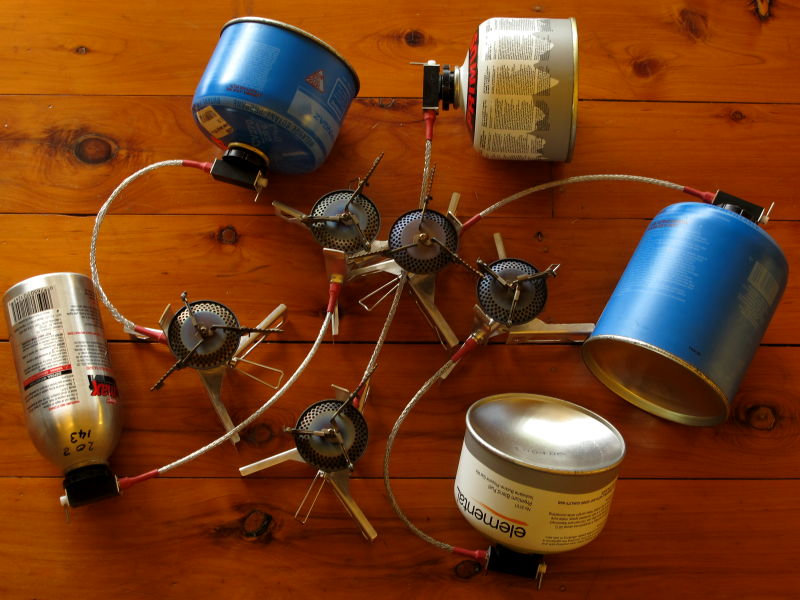
Proof that the stove can handle all three canister designs
In the end, by using a nice fat compressible 3 mm thick O-ring I was able to find a combination which worked fine for all brands and types of canisters, as shown in the photo here using the FMS-116T burner version. The Powermax is at the left; the blue canisters are the French Campingaz ones, and the whitish ones are two brands of screw-thread. Yes, they all worked like that. One could select a slightly different size pin optimised for just one canister design, and be prepared to change the pin when the canister brand/design changes, but it really is not necessary.
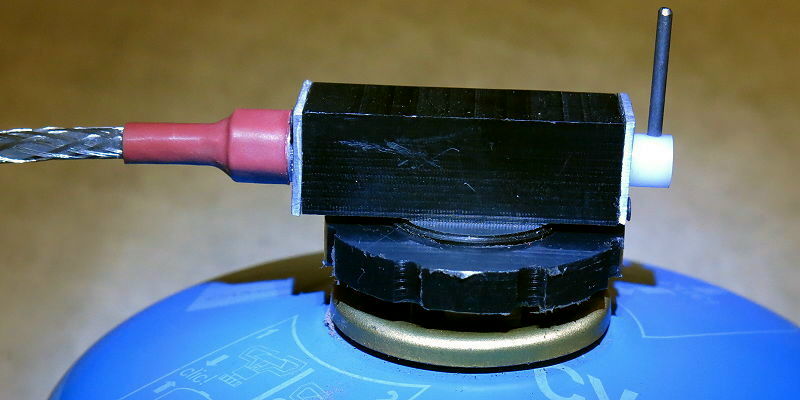
Control valve on the canister connector
Here we have the complete canister connector hooked up to a Campingaz canister. The cam-valve is shown in the fully open position: the Ti wire points up away from the canister, meaning the actuating pin is 'up', or not pressing on the valve. Rotate the handle so it points downwards and the pin is now in the 'down' position, pushing the valve downwards and open. Flick the handle up and the fuel supply is cut off (although there is still a tiny bit of fuel in the hose still). Everything in this picture can be field-stripped for cleaning with a small Phillips-head screw driver. Just don't lose the screws or the pin. I do any field stripping over a large white handkerchief inside my tent.
To attach the connector to a canister you first 'unscrew' the solid core from the spider a short distance, until the solid tip is clear of the lumpy lugs. This lets the fingers compress inwards a bit. Then you insert the fingers part (the 'spider') into the Lindal valve: the lugs 'pop' in past/under the rim. If they don't pop in easily, the core (or the spider) needs to be unscrewed a little more: force is not needed. To anchor the connector to the canister once it has been inserted, you do up the core by screwing it in. This first locks the lugs in place as the smooth top end of the threaded bit slides between the fingers in the lug region (see previous photo).
With a bit more screwing the O-ring comes into contact with the spigot on the Lindal valve. You continue to do the core up till the fit feels firm. Not too much force is needed, and it easy to tell when the O-ring is compressed. When the fit feels secure and the stove has been placed upright in place on the ground, then (and only then) you turn the Ti wire handle of the cam to drive the brass pin into the valve and let gas flow. At this stage you can have the needle valve on the stove shut or open - if the latter you quickly light the gas.
An early stage of field testing (quite a few years ago) caused a significant modification to the original threaded core. I was removing the connector unit from the canister by spinning the core out of the spider one evening. Fine - except that the spider spun right off the end of the core and fell on the ground. Oops! So the non-threaded rim which is pointed to by the red lines in the previous photo was added to the core to prevent this ever happening again. Actually, it is fitted after the spider has been threaded on the core, and you have to remove it if you want to remove the spider. You can see the two retaining screws in the previous photo. This rim piece has a secondary function: it also holds the O-ring (brown line in previous photo) in place inside the connector.
Stock PFA tubing with an OD of 1/8" (imperial, because it comes from America) and an ID of 1/16" is readily available from a number of companies, and this size was selected. Note that this size is about half what older stoves use: they often use 1/4" hose meant for race cars. This smaller gauge tubing has a working pressure rating of about 190 psi (1,300 kPa) at 100 C and 103 psi (710 kPa) at 204 C, and a minimum bend radius of 1/2" (12.7 mm). Note that the pressure ratings includes an engineering safety factor of at least 4x. Ultimate burst pressure is about 1,200 psi (8,275 kPa) at 72 F (22 C). Just a little safety margin, don't you know? PFA has a maximum service temperature of 260 C (500 F) and a low temperature embrittlement point of -196 C (-320 F), although an upper temperature limit of 200 C is safer. Those specifications would seem to be adequate, and I don't think there is anything better available on the market anyhow.

Stainless steel braid over the 1/8" fuel line
Despite the excellent mechanical specifications, I decided that the PFA hose should have some braid over it for several reasons. The first is mechanical protection, but really that is minor. The second and main reason is safety: I do not want the PFA hose pulling out of the hose connector (see below), even under serious abuse. I saw SS braid running over the hose and anchored at each end as being a way of preventing that: any load goes on the braid rather than on the hose. Stainless steel braid of any desired size can be obtained. Larger diameters can be obtained by the metre, but the smaller diameter needed here was harder to get. I had to get it custom-made. It can even be made with the weave you want. Needless to say, a Taiwanese company was happy to oblige. The rather neat result is shown here.
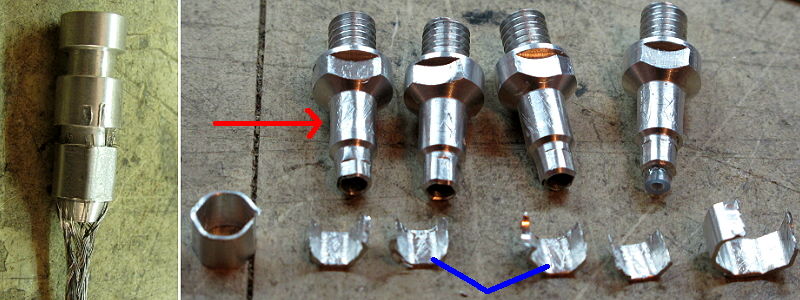
Hose connectors disassembled, showing crimp marks
The braid is crimped to the outside of the hose connector at each end while being pulled tight over the plastic hose. At the left we have an (older model) aluminium connector without the plastic hose, showing just some braid and a tubular crimp ring which is crimped over the braid to hold it in position. The crimping is done with a commercial hex crimp tool, as may be seen from the shape of the crimp rings. You have to get the dimensions of the ring and the core just right to make a good crimp, and you have to use the right aluminium alloy as well. At the pressures used for crimping the SS braid actually gets indented into the aluminium core, as subsequent forensic examination shows here on the right (more older designs). The wire marks are visible on the barrels pointed to by the red arrow, and on the inside of the disassembled crimp rings pointed to by the blue line. The crimps look solid.
The example shown at the left was one of a number which were tested to see when they would fail: once I had the dimensions right for the crimping the braid onto the hose connector, I found the connection would take over 25 kg (57 lb) without any sign of slipping. That's about 7 terra-cotta house bricks freely hanging. This seemed rather more than adequate for a UL stove. Note that the SS braid itself could take this sort of load very easily. I rather doubt the fit between the plastic hose and the connector could hold this force, but the whole point of having the braid there is that it does not need to.
In essence, the PFA tubing looks after the gas, while the SS braid looks after the PFA tubing. Yes, the single connector on the left of the photo and the four connectors on the right are older designs, but the dimensions where the hose goes inside the connector and the braid is anchored over the end are the same, as are the critical dimensions for the crimp ring. The rest were details which evolved over time.
The four connectors on the right show an attempt to crimp the connector onto the PFA hose as well: that's the smaller diameter crimped bit at the near end in the photo. It actually work quite well for retention, but the hex crimp process gave the crimp ring six little corners bulging out. It's a hex crimp, after all. These corners allowed a tiny amount of gas to escape in just one case out of several test pieces, even though I had tried to prevent that with some silicone sealant. A leak like that was a serious oops, and I discontinued the whole idea. (For the technically minded: the silicone sealant cannot bond to the PFA tubing, so the long-term reliability of any silicone seal there is suspect anyhow.)

Tensile testing of the PFA/hose connection
I developed a substitute for the barbed connector design mentioned in part 2 to anchor the PFA hose inside the hose connector. In addition to anchoring the hose, this also serves to make a gas-tight seal between the aluminium connector and the hose. I mentioned above that the SS braid rather than the PFA hose carries the load: this is true, but it is always good to have a backup. It is also good to know how good the backup is. So I set up a very simple tensile testing measurement to see what force was needed to pull the hose out of the connector. Very simple, because for something like this you just don't need 1% accuracy. I am not sure you even need 10% accuracy in fact.
In the left hand photo here we have a short length of PFA tubing with a canister hose connector fitted to each end, being tested. The connection at the lower end was made 'over-strength' deliberately. It is worth noting here that PFA hose is in fact very slippery, and the hole in the aluminium is quite smooth. Getting a grip is not easy. Fortunately, the hose itself is quite strong.
Tension was increased until 'something happened'. The 'something' was the hose slipping out of the upper connector, and this is shown on the right. The black line (from a marker pen) on the hose was originally up against the end of the connector, which also shows some black. Under load the hose slipped out a short distance. The load required for the slip was about 6.3 kgf (14 lbf) in the case shown. Production connections may be slightly stronger as I have since refined the dimensions. Given that no great strength is required here since the SS braid looks after that, I think the connection is strong enough.
Of course the hole down the middle of the hose can hold a lot of liquid fuel, and this can take some time to burn off after the on/off valve at the canister has been shut. The normal thing to do here is to partly fill the bore of the tube with a filler cord of some sort. Enough room has to be left for some liquid flow, but the remaining volume is reduced, with the stove shutting down only 5 - 10 seconds after the on/off valve has been shut. In technical terms, the cross-section of the 1.6 mm bore of a tube is about 2.01 mm2, the cross section of the 1.2 mm polyethylene filler cord ultimately used is about 1.13 mm2. Inserting this filler cord reduces the fuel in the hose to about 56% of the original, assuming the cord runs the full length.

Filling up the bore of the fuel line
There is in fact a delicate balancing act here. If the filler cord is too thin then a lot of fuel is left in the bore, which is annoying. But if the filler cord is too big there may be too much restriction on the flow of fuel down the hose. I tried a 1.5 mm neoprene filler cord in the 1.6 mm bore of the hose used, as illustrated here. This reduced the free cross section to about 12% of the original, which at first seemed reasonable. However, the hose is long and that created too much restriction over that length and not enough fuel came through fast enough. I dropped the diameter of the filler cord to 1.2 mm (removing about half the volume) and that seems to work quite well. Further possibilities are still being explored, and are mentioned under Heat Exchanger below.
Initially I wanted the hose to have the same connector at each end. However, that early requirement lapsed when I decided that the hose would not normally be disconnected at either end. This was fortunate as the plain hose connector I favoured at the canister end did not suit the stove end. The canister end hose connector is a simple cylindrical plug with an O-ring, as shown above under 'Hose Filling'. This plug has to be a neat fit in the hole in the canister connector unit before the O-ring is added to avoid any significant 'wobble' in the fitting. Too much wobble and the O-ring seal becomes suspect. Some dimensions are critical here, but the CNC machine and a good reamer were quite adequate. Note that this connector can rotate inside the canister unit, so the hose is not 'fixed' in position - a requirement.

Stove end connection, showing heat shunt as well
The hose connector at the stove end was persuaded to do triple duty. In addition to connecting to the stove in a leak-proof manner, it has to clamp the heat shunt very firmly to the stove body for best heat transfer and let the hose rotate with respect to the stove body. That neatly skips over a huge number of other heat shunt designs, but we will return to the heat shunt itself later.
The outer part of the connector (blue line) is a threaded sleeve which clamps the heat shunt (red line) very firmly against the stove body, for good heat transfer. The inner part (green line) carries the hose and the O-rings (and the braid), and this is mechanically retained by the outer sleeve. The O-rings do the sealing. A little complex, but very effective and the hose rotates nicely. And yes, some of this design work went around in a few circles for a few years at first, as different combinations were tested.
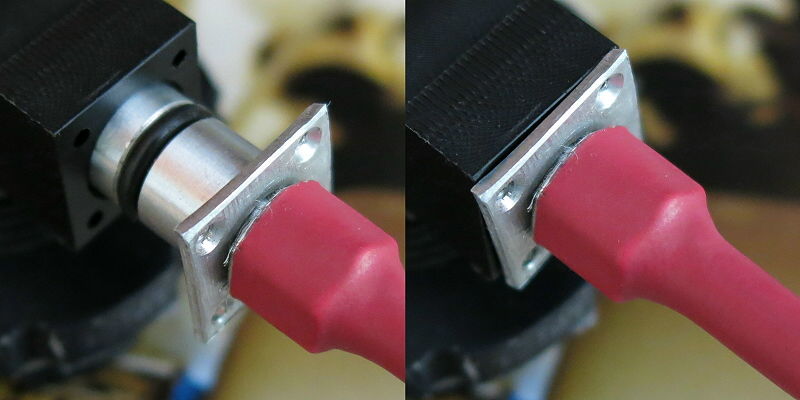
The retainer plate on the canister connector
The canister connection unit has an smooth bore running through it, which takes both the hose connector and the on/off valve cam. Having got both of those into the bore, you have to keep them there with some sort of retainer. If you don't, the pressure of the gas blows them out very quickly (yup, tested). I explored many different ways of doing this, with an initial idea of making it easy for the user to disconnect each end of the hose for packing. However, extensive field testing over several years showed several things. First of all, quite a few designs ran the very real danger of damaging the small O-rings used for the sealing. With high pressure gas any damage (ie leakage) is a definite no-no. Then I found that I never really bothered to disconnect the hose at either end in the field anyhow. By keeping the connection 'made' all the time, I also kept dirt from getting in the hose or on the O-rings.
In addition, one or two 'exciting' incidents where other sorts of retainers failed to retain the hose connector in the bore persuaded me that a semi-permanent connection would be a lot smarter. 'Quick-release' did have its problems! So I ended up with a simple plate with a hole in it screwed to the block it was going into for both the hose connector and the valve cam. The photo shows the screw holes but not the screws. Note that use of this idea allows the hose to rotate in the canister connector unit, as previously required.
I have mentioned O-rings several times. There is a choice here. Nitrile O-rings are cheap, can handle the fuel and are rated for -40 C to +121 C (-40 to 250 F), but Viton O-rings handle a higher temperature range of -32 C to +205 C (-25 to 400 F) and are not much dearer in total dollar value. Under normal use by walkers I suggest that the Viton lower temperature rating is adequate, and the high temperature rating is very desirable, especially at the stove end. If you are planning on being around at -40 C or lower, you might want to switch to nitrile. Note however that very rarely is the stove sitting at such low temperatures, especially in use. But it can get hot.
Some stove vendors use double O-rings in places: two in one groove. This seemed a bit unnecessary to me, so I checked with a major USA O-ring manufacturer. Their technical department confirmed my suspicion: using double O-rings does not help - as long as you get the dimensions of the O-ring grooves correct. Easy enough to do: there are design tables for that. CNC machines are good at being accurate.
All sorts of designs were explored, as explained in Part 2, but many of them proved to be a bit too heavy. I wanted to keep the weight very low. Some of them were a bit of a pain to manufacture too. I also needed to make sure the heat flow from the heat shunt (the bit sticking up into the flame) to the gas worked properly, and that the gas flow path (the 'heat exchanger region') was long enough for the fuel to properly vaporise. To cut a very long story very short, what I ended up with is shown here. We have just lightly skipped over several years' hard work and a huge number of test units. We have also skipped over many failures too.
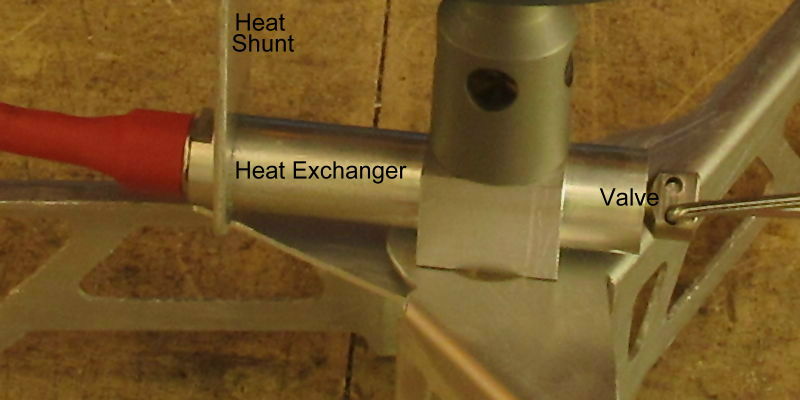
Stove body showing parts
The needle valve (at the right hand side) which comes with most commercial stoves is very short. By using a commercial burner I got the needle valve for free, and was able keep that part of the stove body short. (Yes, I can make the needle valve if needed.) With the layout shown here I was able to have the fuel flow towards the point of the needle, which I explained in Part 2 seemed to be better for self-cleaning. The rate of change in the flame as you rotate the needle valve is of course exactly the same as you get with the commercial stove it came out of. For the needle valve used this rate of change is slower than the old '1/2-turn from off to full on' you get with some older generation liquid fuel stoves. This means control is good.
At the left hand side in the above photo we have the hose connector (with red heatshrink tubing) coming in and clamping the heat shunt, which is the strip of aluminium going up into the flame. First of all I had to decide how thick and how wide the heat shunt should be. A bit too thin and/or too narrow meant that not enough heat was conducted down it. Really too thin and the tip could even melt, as has happened to some commercial heat-exchanger pots. On the other hand, too much heat coming down the shunt could make the whole stove (including the O-rings and the hose) a bit too hot. It's a balancing act. I found that a reasonable thickness of 1.2 mm and just the tip of the shunt sticking into the flame works and does not melt. More heat is needed when the stove is turned up, but then the flame around the shunt gets bigger, so that works.
How hot does the stove body get with this heat shunt? In the field I try to have the stove body a little bit too hot to touch - a little bit 'ouch'. That means it is probably a little bit over 50 C, which is fine for the tubing and the O-ring. In general I try to ensure that the stove body never get to the boiling point of water (100 C), and that is easy enough to test for (spit on finger and touch). In practice very slight tweaks of the heat shunt towards or away from the flames can be used for fine tuning if you want. Note that both the Viton O-rings and the PFA tubing can handle 100 C very easily; they can both handle over 200 C in fact. This is a deliberate safety factor.
Unstated so far is just how far the heat shunt should be from the jet (inside the burner column). The shorter the tube sticking out to the left (usually called the heat exchanger section), the lighter the stove is, but the less time/distance there is for the heat to vaporise the fuel. I did try putting the heat shunt at the very centre of the stove body, away from the Viton O-ring in the connector, in the hope that it would warm up the whole stove body from there, but for several technical reasons that idea did not work. Total failure in fact. Some of my experiments here were featured in my recent article at BPL on Thermal Feedback in Stoves. But putting the heat shunt out at the end of the input tube as shown here does work well.
Not visible in the photo are the details inside the heat exchanger section. Obviously there's a hole going through the heat exchanger section from the connector socket to the needle valve seat, and the hole is large enough that liquid fuel can get through to the jet. Actually, it has to be somewhat larger than needed in order that it can be drilled on a production basis. Very long thin drills are very expensive and break easily. Getting the broken drill bit out is ... difficult. But you don't want the fuel rocketing down the middle of this hole and not getting enough heat pumped in for full vaporisation. How or why that happens was discussed in the previous Parts of this article. When it happens you get drops of liquid fuel coming out the jet and much spluttering of the flame. That's both dangerous and inefficient. So the hole is partly filled with an aluminium rod (Heat Exchanger #1) down the middle and the fuel is spread out into a thin layer between the rod and the inner walls of the hole. Heat transfer into this thin film of fuel is good. Trying to run the stove without this part of the heat exchanger in place is definitely not good.
Not shown in any of the photos here is a length of copper wire (Heat Exchanger #2) which goes up inside the PFA hose. This takes heat from the stove body up the hose to pre-warm the fuel, and is in addition to bit of aluminium rod. Actually, this tiny bit of esoteric design is reminiscent of the long brass rod in the fuel line of the Coleman Xtreme stove. Many have wondered what it is for. By now its function may be obvious: in addition to just acting as a filler, it acts as a fuel spreader and heat exchanger. But Coleman very carefully never explained it. (Did many in Coleman understand what it did? One wonders.)
A caution: this heat exchanger rod can be easily lost when the connection is undone. Of course, when you reassemble the stove without the heat exchanger the stove splutters away, reminding you. Field strip the stove over a large white handkerchief or bandanna.
Later editions of the stove (after about the first 40) feature a modified Heat Exchanger system. The short aluminium rod HE #1 was replaced by a fatter one in a bigger hole, making the drilling easier. Also, the short fat aluminium rod is now crimped to the longer copper HE#2 wire. This improves the movement of heat into the PFA hose, and makes it much harder to lose either part of the heat exchanger.
While typical butane/propane mixtures vaporise a lot more easily - at far lower temperatures, than white gas or kerosene, you still need to turn that liquid fuel into a gas. Typically this means the stove body - the heat exchanger part, must be over the boiling point of butane, which is about 0 C (32 F). To get the fuel to vaporise reliably and quickly, the heat exchanger region needs to be above 10 C (50 F) at least. This means the stove still needs to be 'primed', or warmed up.
I find that handling the stove while setting it up usually gets it above 0 C. Carrying the canister in my pack near my water bottles means it is probably above 0 C as well, as my water bottles do not freeze even on snow trips. They travel next to my back of course, and my back is usually quite warm. So I hook my canister up to my stove in gas flow mode (canister upright) and run the stove on low to medium power for about 10 seconds while monitoring the heat exchanger region. As soon as it feels slightly warm I carefully invert the canister to get a liquid feed - the whole point of the design.
However, what you will find when you do this is that the flame height may drop, by somewhere between a little bit and a lot. This may seem like a worry, or counter-intuitive, but it is correct. What has happened is that you now have liquid fuel travelling down the hose (with its filler cord) and through the heat exchanger instead of gas. This liquid fuel has a much higher viscosity than the gas, so there's much greater resistance to the flow of the liquid than there is for a gas. And this means there is a pressure drop down the hose and through the heat exchanger, so there is less pressure at the needle valve and the jet to drive the flow. So the flow through the needle valve and out the jet drops and the flame goes down. All quite logical. The solution is perfectly simple: open the valve a little more - carefully. Yes, this is normal and it works.
With a Powermax canister you have to prime the stove a bit differently as you cannot start with a gas flow. These canisters always give a liquid feed. So I use a low setting for a little while the heat exchanger section warms up, and ignore the occasional splutter. With some practice I can use this approach with other canisters too - carefully. Yes, priming a canister stove is much easier than priming a white gas stove, but you still need at least some priming in cold weather.
As mentioned in Part 2, I can make the jets but it is slow work - and a jet comes free with every burner (along with the needle valve). So I use the jet supplied with the burner. That has a small benefit as well: the jet size is usually well-matched to the burner. All that is necessary is to make sure that the top of the jet is placed at the same position with respect to the air holes as on the original stove.
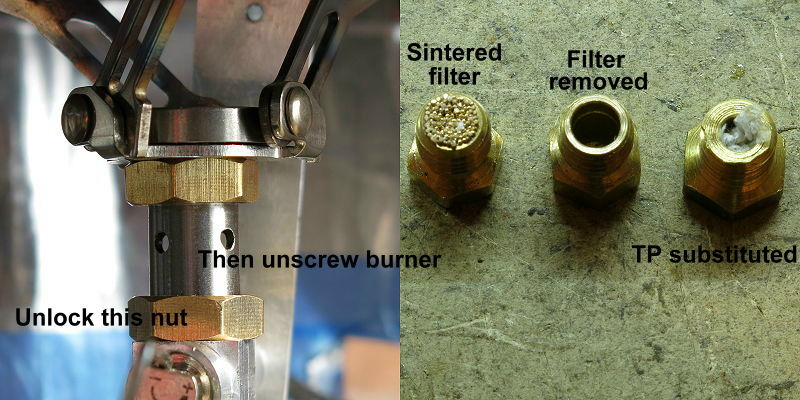
The jet and the undesirable sintered filter
Some Asian stoves have a sintered filter inside the jet. The theory is that this protects the tiny hole in the jet from getting blocked, but when the sintered filter gets blocked you have no way of cleaning it. That rarely happens with an upright stove as the dirt stays in the bottom of the canister, but it can and does happen with an inverted canister if there are any contaminants (dirt, dust, heavy waxes) in the fuel. These contaminants do happen. When I bought the stoves I specified that the jets should have no sintered filter in them. The supplier had no trouble with this idea as it saved them a process step. Instead, I place a tiny bit of tissue or toilet paper in the cavity at the back of the jet as a replaceable filter. I emphasise 'tiny': you don't jam a lump in there like loading a musket. That would block the gas flow too much.
The photos here show how to access the jet (you will need a spanner for the lock nut on the burner tube and a smaller spanner for the jet) and what the filter looks like. As you can see, it is very easy to replace the tissue paper in the field. If you do have to remove the jet to replace the clogged bit of TP in the jet, it's a fairly simple process. When you replace the jet in the socket make sure it is screwed in moderately tightly to avoid leaks around the edge of the thread, but don't strip the thread! Just a gentle action to snug it up.
Later editions of the design replaced the wad of tissue paper with a disk of filter paper under the jet. I use bits cut out of laboratory filter papers, but a coffee filter works just as well. I found that this made for more consistent operation and also made priming easier. In fact, with this sort of filter in place I often start the stove with the canister inverted.
The burner comes with pot supports at the top, but the stove body needs supporting and bracing to stop the stove from falling over. In my article at BPL on Recent Stove Developments I pointed out that an equally valuable part of the pot supports could be a solid brace in the middle, to actually carry the weight of the pot. This was also mentioned in Part 2 of this series. In fact, I found that the strength needed in the legs (and hence their weight) could be halved by having that central support as part of the legs.

Stove legs, without and with central support
The photo here illustrates this for early versions of the design, before I went into production. It is not hard to image that putting a heavy pot on the left hand set of legs is going to push the stove downwards and bend the legs in the region of the pivot. Over time these legs can get quite distorted near the pivot. (Experimentally verified, I assure you.) But the legs at the right cannot let the pot sink downwards: there is a very strong central support, for up to a couple of litres of water at least. What this means is that a good design for stove legs is one which offers both central weight-bearing support and large-diameter bracing support. Of course, when the legs are made with a bend along their length as shown here they are much stiffer as well. I can stir a full pot of stew for two on this with no trouble at all - but I do use a pot holder. The total weight of the three legs is just 11 g, and they are made out of 0.8 mm thick aluminium. Thicker legs, using say 1.0 mm aluminium, are possible but 25% heavier.
However, before I actually shipped any stoves I found that I could use a conventional tripod without a centre support and without the stove wobbling all oveer the place. I changed the design of the pivot in the middle to give greater rigidity and all was wonderful. This is what comes out of proper and adequate field testing!

Plywood bases with different ways of holding a stove
It is worth noting that this design does mean you need a flat surface for the stove. You can sit the stove on the ground and rely on the tips of the legs for all the support, but that is not as good as having a good flat surface with a centre support. I often use a small bit of light plywood for a stove base, and that improves the stability all around. It is also almost mandatory when using the stove in the snow, where the plywood also insulates the stove and the heat exchanger region from the cold snow. I tried other materials, but light 3-ply beats them all when you combine weight, heat resistance, stiffness and insulation properties.
I mentioned in Part 2 that a very light stove can be a bit skittish if you aren't careful, and that this can be problematic. One solution I offered there was to stake the stove down with 'micro-stakes'. On the left we have a simple ply base with micro-stakes securing the stove. That works quite well, but only if you can get the micro-stakes into the ground. On sheet rock or a wooden table that can be tricky. In the middle photo I have glued a small ring of ply in the middle of a plain stove base, to locate the central leg support. The ply ring can't be very high as the gap under the legs is not big, but I found that even just a little ring worked quite well to stabilise the stove. I also lightly grooved the ring in three places to help locate the legs. This turned out quite stable and works well on sheet rock and similar places where stakes won't go in. Finally, on the right I have combined the two ideas. OK, all that required was that I drill the three holes for the stakes in a base with a centre ring. With this idea I get the best of both worlds - and the ply base lasts for many years if you don't use it to dig holes.
You don't have to, but I find that a couple of coats of some sort of clear varnish stops the ply from getting wet and disintegrating, especially in the snow. It can make the ply slightly more slippery, but the ultra-light stakes keep the ply from sliding on the ground and the stove from moving around on the base. Alternately use a thick gloopy coat of varnish to make a non-slippery surface, or even a few stripes of silicone sealant.
Hidden out of sight under the legs at the pivot point is a spring or wave washer under some compression. This washer stops the legs from spinning around freely. When you open the legs out, they stay opened where you put them. This too adds a lot to the stability.
Let me insert a warning here. This is deliberately an ultra-light stove. If you put a great big pot on this stove and treat it roughly, you will have an accident - even with the stakes holding the stove in place. If you suddenly move the canister without taking heed of the stove, the stove may well move in an 'uncontrolled' manner, where 'uncontrolled' could mean tipping upside down and setting the place alight. Mind you, that can happen with many stoves, so it is nothing new. If you want to stir vigorously on any stove, hold the pot with a pot holder while you are stirring. Take care!

Two different burner heads: FMS-116T and FMS-300T
Part 2 of this series showed some of the huge range of burner designs that I tested. All good fun, but in the end I decided to use a commercial burner to simplify the manufacturing. There were several possibilities. In particular, the Fire Maple FMS-116T (left) and FMS-300T (right) stoves are neat and some of the lightest stoves around. The FMS-116T has a slightly larger diameter to the tips of the pot supports than the FMS-300T, which makes the FMS-116T slightly more attractive on the grounds of stability alone. However, there were other rather important considerations.

Clearance between the burner head and the pot for the two different stoves
In particular, I want the stove to be very clean, with low CO emissions. The FMS-116T in the left has the pot base very close to the top of the burner, while the FMS-300T on the right has a much greater clearance. We know from my research into CO emissions published at BPL that burners with a low pot clearance or lots of metal in the flame close to the burner often produce higher levels of CO due to quenching of the flame, so these stoves had to be measured in the equipment previously used in that research. Incidentally, each of these stoves was actually burning: the flames are very pale blue. That colour is good.

CO performance for the two stoves (see explanation below)
Here we have the relative performances plotted against time on the X axis, but the graphs do need some explanation. For a start, the left hand graph has two sets of measurements shown in parallel. The straight lines represent any added clearance I placed between the top of the burner and the bottom of the pot: 0 mm or 10 mm. The jagged lines represent measured CO levels. The right hand graph does not show clearance, just measured CO levels measured as parts per million (ppm). There was no added clearance.
On the left we have the FMS-116T. Ignition for medium power was at ~40 seconds (blue line) with zero added clearance. As you can see, the CO level started quite high (just over 100 ppm) but fell over a couple of minutes to about 50 ppm. By about 80 seconds after ignition (120 seconds on the axis) the pot supports had reached a dull glow (visible in the previous photo) and were no longer quenching the flame so much, which explains the fall in CO level. At 220 seconds the pot-to-burner clearance was increased from the default 0 mm value (ie on-the-supports) to 10 mm (brown line), and the CO level fell significantly, down to an acceptable level of around 15 ppm. There was now more space between the burner and the pot for the combustion in the flame to get past the CO+O->CO2 stage before it hit a 'cold' quenching surface - the bottom of the pot.
At 320 seconds the stove was turned up to high power (green line), and the CO level rose a bit to almost 30 ppm, as might be expected. But note that the clearance is still at +10 mm. So at 420 seconds the clearance was dropped back to 0 mm (ie the pot was now back resting on the pot supports) with the stove still on high power (purple line), and the CO level doubled to almost 60 ppm. The flame was being quenched again by the pot.
Finally, at 540 seconds the stove power was dropped to a low simmer level (light blue line), with the pot on the supports. As might be expected the CO level dropped right down to under 10 ppm: the flames were now only just reaching the base of the pot. There was no quenching.
On the right we have the results for the FMS-300T. Ignition to medium power was at ~30 seconds (blue line) with the pot sitting on the supports. The CO level jumped up a bit, but to a relatively minor level of about 35 ppm, then fell back down to under 20 ppm as the pot supports heated up. They were glowing by the end of this period. As noted in my article at BPL on Recent Stove Developments, this stove is noisy with a recirculating vortex-style flame. At 350 seconds the stove was turned up to high power (it got louder), but the CO level did not change (brown line). it would appear that the space between the burner top and the pot was sufficient to allow adequate flame mixing in vortex mode and for the CO+O->CO2 process to largely complete.
At 510 seconds the stove was turned right down to very low (green line). At this stage the noise died completely, the flames were only about 10 mm high and quite blue, and the pot supports cooled off to 'dark'. One could say that the stove had reverted to a 'quiet burner' mode, with enough oxygen being sucked in through the small air holes. The flames were clearly getting enough oxygen as the CO level dropped to near zero. Finally at 620 seconds the stove was turned up just a little to a 'lowish' level (purple line) and the CO level went up by about 2 ppm. Yeah, all of 2 ppm, barely resolvable with the CO monitor. A lot of my cooking is done at this low power.
What to make of all this? First I would say that the FMS-116T needs more pot clearance and less metal directly over the burner. Provided you have good ventilation and do not run flat out, the levels of CO become reasonable after a minute or two. On the other hand, the FMS-300T starts much cleaner and quickly reaches an acceptable level for high power. At medium to low power it runs very cleanly indeed. So I favour the FMS-300T by a small margin.
Sadly, it is not possible to switch burners easily on the same stove body. The FMS-116T uses an M12x1 mm thread at the base; the FMS-300T uses a M9x0.75 mm thread. On the other hand, the manufacturing change for the stove base simply meant changing a couple of parameters in the CNC program. That's easy.
Some older stoves have long flimsy pot supports; you know which ones I mean. Both of these FMS stoves have strong Titanium pot supports. The FMS-116T has a slightly larger support diameter, but not by much. Field testing both stoves for a couple of months on a long walk in Europe in 2012 showed they both worked just fine. In fact, in my experience the Ti pot supports seem to grip the pots a bit, in comparison with some round plated wire pot supports which feel decidedly prone to sliding. In the end I let the CO consideration win and selected the FMS-300T.
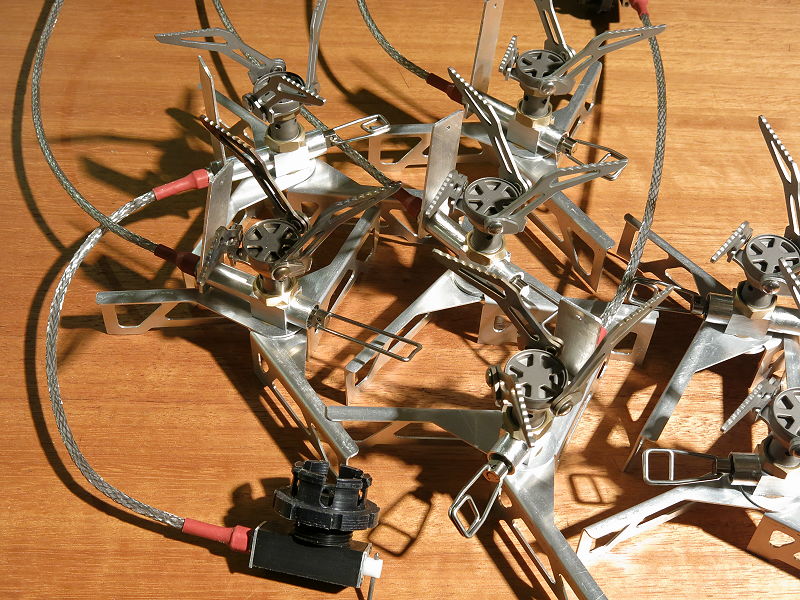
Some finished winter stoves lined up
Yes, we had to get around to this eventually. At this stage (Xmas 2013) the stove is in the 'beta-test' phase. Early versions have been in field use by me for years, and this final model has been in field use by me for many months in the first half of 2013, and I am very happy with it - but I made it. The design still needs beta-testing and feedback.
I have been making 'beta-test' copies of the stove for field testing on my CNC machine. The third photo in this article shows some of the first batch I made with the FMS-116T burner: I made only 10 of those becasue that was all the FMS-116T burners I had. The photo here shows what the final design with the FMS-300T burner looks like. I have been making batches of those with my CNC machine, so there are a limited number of stoves available for beta testing. If someone wanted commercial quantities, such as several thousand, it would make sense to get injection molds made for both the plastic and the aluminium parts (and I have contacts for that), but doing it that way costs several thousand dollars per mold. There are quite a few bits in every stove. So yes, there are some available for further beta testing (early 2014).
To cover all the costs of manufacture would be impossible. In a brief survey I found that the average retail price for a liquid fuel stove, going over several brands and several models per brand, is about $140. So that seems a fair retail price. Payment is by Paypal. If you want to contact me about this, use my email address roger@backpackinglight.com .